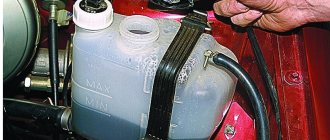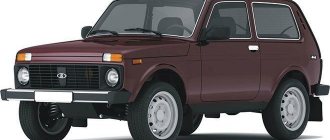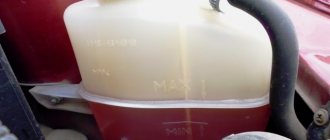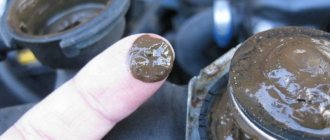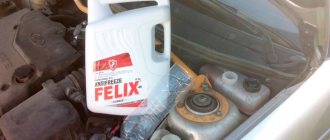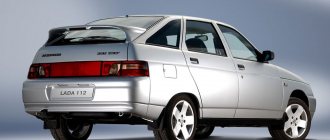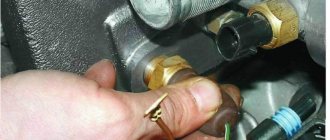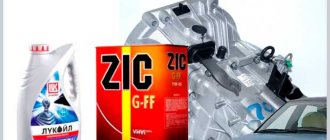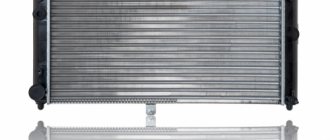COOLING SYSTEM VAZ 2114
Once upon a time, back in Soviet times, water was poured into a car radiator as coolant. But it was very inconvenient - in cold weather it had to be drained regularly so as not to defrost the system, and in the morning before the trip I had to run around with buckets of hot water. In addition, the cooling jacket in the cylinder block and in the cylinder head suffered from corrosion. Nowadays, water is practically no longer used; antifreeze or antifreeze is poured into the cooling system (CO).
The volume of VAZ 2114 coolant in CO is about 8 liters (7.8 liters according to factory conditions). A car that has rolled off the assembly line can be filled with any coolant; the manufacturer does not adhere to any specific rules in this matter.
But if the fluid runs out or the time has come to replace it, then topping up or replacing is necessary. And here you need to know what is poured into the system, and whether it is possible to mix antifreeze with antifreeze.
ANTIFREEZE
The name "antifreeze" contains Greek and English roots. The Greek “anti” means “against”, the English “freeze” translates to “freeze”. Therefore, the coolant located in the cooling system must not only prevent overheating of the internal combustion engine, but also not freeze in frosty weather. The basis of antifreeze is ethylene glycol, and the freezing point of the coolant depends on how much water is added to the chemical composition. The fluid components do not cause corrosion of engine parts.
The composition can be of almost any color; ethylene glycol itself is colorless. The composition is painted so that it can be seen in case of leakage, and so that it is not drunk by mistake; the antifreeze itself is poisonous. In addition, the old coolant changes color, which means it is time to replace it.
Antifreeze
Antifreeze is a type of antifreeze, only at one time it was specially developed for VAZ cars. It has a blue color, and can be concentrated, diluted by 60%! with water (grade A-40M), diluted by 35%! (A-65M). The concentrate is not used in its pure form; it is diluted at your discretion, depending on the freezing temperature that is oriented towards in the region where the car is located. Antifreeze has a more aggressive environment, but this does not mean that it is of low quality.
MYTHS ABOUT ANTIFREEZE AND ANTIFREEZE
- Antifreeze is worse than antifreeze. This is not true. Both coolants are made from the same base (ethylene glycol). But their density is different, and different instruments (hydrometers) are used to measure this parameter.
- The color of a liquid is an indicator of quality, and its composition depends on the color. In fact, the composition of the coolant is basically similar for all, and does not depend in any way on the color. Antifreeze is mainly tinted green and red.
Antifreeze or antifreeze from the factory?
The answer to this question is simple! AvtoVAZ does not maintain a uniform standard, and with equal probability, cars produced in the same year could contain both antifreeze and antifreeze. We have already written in more detail about the choice in the material: “what VAZ-2114 owners recommend: antifreeze or antifreeze.”
There is a lot of controversy about this, but opinions vary significantly, however, as the manufacturer states, it was TOSOL that was specially developed for cars of the VAZ family.
This fluid should be changed regularly and when these cases occur:
- After the last coolant change, the car has already traveled more than 65-70 thousand kilometers.
- Two years have passed since the last replacement, regardless of mileage.
- The liquid has a shade darker than its original color, or there are traces of rust.
This is the antifreeze that was drained at 40,000 km.
Source
Timing for coolant replacement and required volume
First, it is worth deciding on the timing of replacing the coolant on the VAZ 2107. And here everything is simple - every 60 thousand km or once every three years. This is when using original AvtoVAZ antifreeze. If you are pouring a different liquid, you should look at the manufacturer’s recommendations. But it’s better not to change the timing - on domestic roads, the coolant resource is used up quickly.
The volume of antifreeze in the system is the same for all Zhiguli models - 9.85 liters. To replace the coolant in a VAZ 2106, you need the same amount of antifreeze as in a VAZ 2101 or 2107. Here you should take a 10-liter container (or two 5-liter containers). It is recommended to purchase Lada antifreeze. This is an original coolant suitable for any AvtoVAZ car. When choosing an alternative, you should take antifreeze of class no lower than G12, with a freezing point no higher than -40 degrees Celsius.
It is also worth paying attention to signs of depletion of antifreeze life . You need to look at the following points:
- Constant engine overheating. The thermometer needle is in the red zone, the fan is running continuously, and steam is coming from the radiator. It occurs more often in the summer, but in worse cases it also happens in winter. But we must remember: the problems listed can also be associated with malfunctions of the cooling system. If the antifreeze has been replaced and the situation has not improved, it is worth checking the functionality of the thermostat, fan, and water pump.
- Unpleasant smell from the radiator. The decomposition products of used antifreeze smell unpleasant. But we must take into account that the appearance of this smell indicates that all replacement periods have already passed. And it is possible that repairs will now be needed.
- Change in color and consistency of antifreeze. If the fluid has darkened slightly but remains clear, replacement is not yet required. But if the antifreeze has thickened, dirt has appeared, and the color can no longer be determined, then it must be changed immediately.
In the described cases, replacement is carried out immediately, regardless of the timing. It’s also worth considering that there are currently no new VAZ 2107s available. And in used cars, the condition of the fluid should be checked immediately after purchase. And if necessary, replace it with high-quality antifreeze.
It's not just the engine that needs to be cooled...
The car's engine cooling system, as its name suggests, is designed to cool the power unit, since its operation is accompanied by a large amount of heat. Without proper cooling, the motor will not last long - its mechanical parts will jam due to overheating, and all the electronics will simply burn out.
In addition to its main function, it is actively involved in a number of processes occurring in the car. For example, it is a source of heat for heating the interior and air conditioning, reduces the temperature of oil, exhaust gases, transmission fluid, and also cools the air for the charging system if the engine is equipped with a turbine.
In a word, the cooling system is an indispensable link in the chain of components and assemblies that ensure reliable and, most importantly, durable operation of the engine.
Is there a difference in the processes of draining antifreeze in eight- and sixteen-valve engines?
There is a difference, and it is significant. The fact is that the “tens” engines have different designs. In terms of draining antifreeze, a VAZ-2110 with 8 valves is more profitable than a dozen with sixteen valves. The first has a coolant drain plug located on the front of the cylinder block. To get to it, you don’t need to drive the car into the inspection hole or remove the protection. But for sixteen-valve power units, the plug is located at the bottom, and can even be closed by the starter, so before draining the antifreeze from the VAZ-2110, you will need to drive the car into a pit (overpass), remove both the protection and the starter. Let us consider this process in more detail for each of the engines.
Common malfunctions in the VAZ-2110 cooling system
Auto repair specialists identify the following main malfunctions that affect the cooling system:
- leakage of antifreeze and its deficiency;
- due to a malfunction of the pump pump, there is no pressure;
- the cooling fan does not function correctly or does not turn on at all, this is due to errors in the operation of the temperature sensor;
- the thermostat is inoperative, which prevents the circulation of the solution through the large cooling circuit;
- contamination of the plates installed in the radiator.
Monitor the condition of the machine and immediately respond to the appearance of extraneous sounds when the pump pump is turned on.
Experts advise monitoring the level of coolant in the tank and replacing the old one with a new one every 75,000 km of the VAZ-2110.
We recommend: Electrolyte for batteries
To determine whether there are any temperature errors, periodically refer to do-it-yourself methods for diagnosing the cooling system. The radiator, which is responsible for cooling, requires regular cleaning and temperature control when the engine is running.
How to choose the right composition?
In the instructions that come with the machine, the manufacturer advises using antifreeze type D as antifreeze, and Elf Glaceol RX Type D directly. This composition has a yellowish color. The product is supplied as a concentrate. While pouring this mixture, it must be diluted in distilled water. The ratio of concentrate and water should be 1 to 1. The price of this product is about 350 rubles. per liter This element is perfect for 1.4 and 1.6 liter engines. Buy unique concentrates recommended by the car manufacturer. Find these compounds available in stock at dealers. Such compositions also need to be diluted with distilled water. It is sold at the dealer or at car markets.
The Russian product, similar to the Elf brand, has also proven itself to be excellent. It's called Cool Stream 4030 Premium. Replacing antifreeze with Renault Logan involves completely replacing the old water with the newest one. For this purpose you need 2 or more 6 liters. consistency.
Experienced car enthusiasts also successfully use Elf Cool Auto Supra water. Antifreezes from . are also allowed for replacement. These waters do not harm plastic products and rubber parts. The Total composition does not have a destructive effect on paint and varnish coatings. Concentrates are very resistant to freezing. The liquid solidifies only at temperatures below .40 degrees. It makes no sense to combine antifreezes of different colors in the expansion tank for antifreeze. In the meantime, you need to carefully wash the entire system.
How to calculate correctly?
To begin with, it is worth taking such a useful parameter for work as motor efficiency. The efficiency is usually about a quarter (25%!). And everything else goes to various physical (including thermal) losses (which is essentially what we need).
About a third of all energy is spent on such a parameter as heating.
- We will carry out calculations based on the total engine power. Typically, this power is indicated at the moment at the maximum value of engine speed (or in other words, it is indicated at the highest speed, for example at a value of 4000 - 6000; different manufacturers take everything into account differently).
- For a simpler calculation, we take a standard one hundred horsepower engine (100 hp) and convert the resulting power to KILOWATTS.
- To do this, divide 100 by 1.36 equals 73.55 kW (here it is worth considering that 1 kW equals 1.36 hp). It is also worth remembering that this power is calculated at the highest speed.
As a result, the value obtained is 30 percent (this is exactly the amount the motor spends on energy losses). Just think how much this is! It turns out that more than 22 kW is used for heating.
How many liters of coolant
Since the volume of radiators, channels, engine, cooling jackets are different, then, accordingly, the volumes are different for different brands. Therefore, we present data for certain cars.
How much antifreeze or antifreeze is needed in the car cooling system:
- VAZ 2101 - 8 liters;
- VAZ 2102 - 8 liters;
- VAZ 2103 - 8.6 liters;
- VAZ 2104 - 8.5 liters;
- VAZ 2105 - 8.6 liters;
- VAZ 2106 - 8.6 liters;
- VAZ 2107 - 8.6 liters;
- VAZ 2108 - 7.8 liters;
- VAZ 2109 - 7.8 liters;
- VAZ 21099 - 7.8 liters;
- VAZ 2113, 2114, 2115 - 7.8 liters;
- VAZ 2110, 2111, 2112 - 7.8 liters for both 8 and 16 valve engines;
- VAZ 21213 “NIVA” - 10.7 liters;
- VAZ 2111 “OKA” - 4.8 liters;
- Lada Granta VAZ 2190 - 7.8 liters;
- Lada Kalina VAZ 23009 - 7.84 liters;
- Lada Priora - 7.84 liters;
- Lada Vesta - 7.84 liters;
- Lada Xray (X Ray) - 7 liters.
Coolant volumes for UAZ vehicles:
- UAZ 469 - 13 l.;
- UAZ Patriot - 12 l.;
- UAZ 452 - 13.4 l.
Volumes of antifreeze Gazelle:
- Gazelles of all modifications: from 9.7 to 11.5 liters.
- Gazelle 3110 - 10.5 liters.
Replacing coolant requires knowledge not only of the process itself, but also of the safety rules for carrying out work. For example, you cannot change the fluid when the engine is hot, that is, you cannot open the engine cooling radiator cap when the antifreeze, antifreeze or water in the system is hot. You may be burned by steam or escaping coolant.
The cooling fluid must be replaced periodically in compliance with the rules and regulations. You also need to know that you cannot mix antifreeze with antifreeze; you can dilute it with water, but this will deteriorate the properties of the coolant.
For cars of the VAZ family, it is recommended to change the coolant after a mileage of 60 thousand km. Some people are used to changing them yearly, for example, they replace antifreeze or antifreeze every 2-3 years.
Flushing
Many experts agree that the system should be flushed before replacing the coolant. But how to do this and is such an event really mandatory?
If the coolant being drained shows signs of rust and contamination, then the system should still be flushed. This preventive measure will never be superfluous. Therefore, try to allocate some of your precious time to the procedure. The engine will remain grateful to you.
Expansion tank
The cooling system is washed quite easily:
- Drain the old fluid by unscrewing the drain plug;
- Fill the system with water through the filler neck;
- Distilled or boiled water can be used as a washing composition. Plus, there are special cleaning compounds. They are more expensive, but their efficiency is higher;
- Start the engine with flushing water inside and let it idle for about 30 minutes;
- Drain;
- If it is very dirty, repeat the procedure;
- Add new coolant to the system.
FILLING LIQUID INTO THE SYSTEM
What kind of coolant to pour into a VAZ 2114 is always a concern for car owners of these cars. There is no big difference, you can pour antifreeze into the cooling system, you can also add antifreeze, but mixing the compounds is still very undesirable. Antifreeze has a more aggressive environment due to other additives, and its too concentrated composition can even “corrode” the radiator over time. It is better to add to the radiator the brand of coolant that was previously filled in the system. If the brand is not known, then it is better to completely replace the fluid.
REPLACEMENT WITH WASHING
Is it possible to replace antifreeze with antifreeze? Why not. It is only necessary to flush the cooling system when replacing antifreeze with antifreeze. Conversely, you need to flush the cooling system when replacing antifreeze with antifreeze. We have already indicated the reason for flushing - the compositions are different and mixing can lead to foaming of the coolant. Of course, an explosion will not occur, but long-term use of the mixed composition is not recommended. The system should be flushed with clean water, and the water should be changed several times. Rinse until clear liquid, free of dirty impurities, drains from the radiator.
Replacing the coolant on a VAZ is done with your own hands in stages:
- We park the car level; at an angle, all the coolant may not drain out;
- Remove the expansion tank plug;
- Unscrew the drain plug at the bottom of the radiator. We prepare the container into which the contents from the radiator are drained in advance;
- We twist the plug on the cylinder block and drain the coolant from the block. To get to the plug, you need to remove the ignition module. The module is secured with three bolts;
- We tighten the plugs, fill in water and start the engine. Let the engine run for fifteen minutes;
- As already written above, we flush the system several times;
- Then fill in new fluid and remove the airlock. How many liters of antifreeze are provided in the VAZ 2114, so many should enter the system.
We recommend: How and which one is better to install a hood lock?
REMOVAL OF AIR CLOCK
How to add antifreeze if there is an air lock? There are different ways to fill liquid (discussed below).
Removing air through the throttle assembly:
- Remove one of the coolant supply hoses to the throttle valve.
- Remove the expansion tank cap and cover the tank with a clean rag.
- Blow through a rag into the reservoir until coolant flows from the removed hose.
- Quickly put the hose in place, tighten it with a clamp, and add fluid to the level. How much antifreeze will still fit into the VAZ 2114 depends on how “airy” the system is.
Removing air through the throttle without removing the expansion tank plug:
- We heat up the engine and turn it off.
- Remove one of the throttle hoses.
- After a short time, the air should come out and antifreeze should flow.
- We also quickly put on the hose.
- Check the coolant level and add it as necessary.
Bleeding air by placing the vehicle at an angle:
- We're heading uphill.
- Remove the tank cap.
- Warm up the engine to operating temperature.
- We accelerate sharply. If liquid falls into the system, add it.
You can change the cooling radiator on a VAZ yourself. In this case, an air lock may also form. You need to control how many liters of antifreeze will fit into the VAZ 2114. If there is a lot of new coolant left in the canister, it is necessary to remove the plug, otherwise the engine may overheat.
It should be remembered that the volume of the cooling system in the VAZ 2114 is approximately 7.5-8 liters.
If you don’t want to bother with replacing the coolant, you can take the car to a car service center. The cost of such work depends on the region and the level of equipment of the car workshop or center. On average, the price ranges from 300 to 600 rubles.
TIPS FOR REPLACING COOLANT
- Hot liquid must be drained carefully, using gloves and thick, waterproof clothing.
- After replacement, you need to check if there is an air lock in the system. The air must be expelled, otherwise the engine may overheat .
- When draining the liquid, cover the generator with a thick plastic bag or rag to prevent coolant from getting into it.
- When mixing antifreeze with antifreeze, nothing particularly bad will happen, but it is still advisable to avoid mixing.
Take into account all the nuances when replacing the coolant. Take care of your car!
What's in it?
So, you purchased a car and don’t know what exactly is in the cooling system. If there is water or already used coolant there, this does not bode well for your engine.
Therefore, first of all, check whether there is any coolant in the engine at all, and what exactly it is. At the same time, make sure there are no leaks from the pipes or radiator.
It is not difficult to independently determine the type of fluid used by the old owner.
- Antifreeze almost always has a blue or blue color.
- Antifreeze is mainly available in red or green. Moreover, there are a huge variety of shades of red.
- It is not difficult to distinguish water from blue or green liquid.
- If the color of the coolant has a characteristic shade of rust, then this indicates the need for urgent replacement.
Green antifreeze
Mixing different coolants. Yes or no?
In some cases, the quality of the fluid is good enough that it is not necessary to replace it. Only the quantity is somewhat below the required level.
Let's say you have antifreeze filled, but you only have antifreeze on hand. What to do in such a situation? Many VAZ 2114 owners are interested in whether it is possible to mix different compounds.
Antifreeze or antifreeze
There is no consensus on this matter. Let us say for sure that a disaster will not occur from mixing, antifreeze and antifreeze will not react and will not explode the car. But we definitely cannot recommend combining two types of coolant in one tank. Follow the instructions in your car's manual, fill in what the factory recommends, and then you won't have any problems.
Antifreeze is simply a type of antifreeze developed in Soviet times for Zhiguli cars. This was done due to the low quality of the antifreeze offered at that time. Since then, antifreeze is the number one choice for VAZ.
Preparation for replacement and necessary tools
You should start by preparing the car and workplace. The machine is placed on an overpass or above an inspection hole. It is recommended to leave it on the handbrake and at speed. And place “corners” under the wheels: stoppers to hold the car. After installation, it is worth checking the position of the machine. It should be level, or the front should be higher than the back. Other options are unacceptable.
The next stage of preparation for replacing the coolant in the VAZ 2107 is choosing tools . The list is short:
- A key for 13. It is recommended to additionally take a key for 8 and an adjustable key for 30. It is worth considering that used cars do not always use “original” spare parts. Therefore, the sizes of nuts and bolts may differ from the standard. Because of this, experienced drivers prefer to keep a set of keys of different sizes on hand.
- Screwdriver Set. It is worth having a flathead and Phillips screwdriver with you.
- Container for draining used antifreeze. Volume - 11-12 liters.
- Hose for the drain hole on the engine. Needed to remove antifreeze from the internal circuit of the system.
- Antifreeze to replace. Recommendations for selection and required volume are described above.
- Funnel for filling new coolant.
- WD-40 or equivalent. Used to remove dirt and rust from bolts and plugs.
Safety recommendations:
- You need to work on a cool engine. If the antifreeze is hot, allow it to cool. It must be remembered that the operating temperature of the coolant is 60-90 degrees. You cannot open the radiator and check the condition of the antifreeze. After all, the liquid, while hot, is under pressure in the system.
- The machine should be carefully secured in place. Any negligence in this matter can result in serious injury.
- Replacement is carried out in a well-ventilated area. It is worth remembering that antifreeze fumes are bad for your health.
- During operation, antifreeze must not enter the body. In particular, it should not come into contact with the eyes, mouth or respiratory tract.
Now you can proceed to the actual antifreeze replacement procedure. Conventionally, it is divided into three stages : draining the old coolant, flushing, and filling in new antifreeze. Each stage should be described separately.
Draining old fluid
First, you should remove the crankcase protection . And here it is worth remembering - on Zhiguli cars it is often in a deplorable state. The plate should be washed before removal. The bolts are treated with WD-40 to remove rust. If necessary, the entire part is cleaned of rust. The bolts are carefully unscrewed and the crankcase protection is removed. An important point: on old cars, the bolts rust and become brittle. If handled carelessly, they may break.
The heater lever opens in the cabin . It is transferred to the maximum position. There is no need to start the stove itself. Then the radiator filler neck and expansion tank are opened. This is done to speed up the draining. Then a container for used antifreeze is placed under the radiator drain hole. There are two options for draining the liquid.
They depend on the radiator model:
- Option with the “native” radiator of the VAZ 2107. The latest models of Zhiguli have a special tap for draining antifreeze. This faucet is treated with WD-40: it has a habit of turning sour. Then it opens and the liquid drains out.
- If a radiator from older models of the series is installed. There is no drain hole provided here. Therefore, the liquid is drained in one of two ways: The fan switch off sensor is unscrewed. It is located on the inside of the radiator, on the right (if you are facing the car). It will require a 30 key.
- Remove the hose from the lower radiator pipe.
After draining the coolant from the radiator, the internal circuit of the system should be emptied. You need to find the drain plug on the cylinder block. It looks like a 13mm wrench bolt. Use the appropriate wrench to unscrew the plug. The waste liquid is drained. To do this, you need to run the used coolant through a hose into a pre-prepared container.
The next step is draining the antifreeze from the expansion tank . You need to unfasten the container fastening belt. She herself is lifted 30-40 cm up. This will allow the remaining liquid to enter the radiator. From there it is drained using the method already described.
Flushing the cooling system
There are three ways to flush the cooling system: with water, household chemicals, and special compounds. And you should choose a method based on your preferences and the condition of the car. However, there is one important recommendation. Washing is not considered a mandatory procedure.
But there are a number of situations when it must be done:
- When switching to another coolant. The composition of different brands of antifreeze may differ. And mixing these liquids is not recommended. Even if both coolants are of high quality. This requires draining and complete flushing of the system.
- When traffic jams form in the system. Cleaning is a must here.
- When replacing the coolant in a recently purchased car. Owners of domestic cars often fill with low-quality antifreeze. And after it, a complete flushing of the system is always required.
You also need to flush the expansion tank . All hoses are disconnected from it and removed from the mounts. The container is thoroughly washed from the inside. Then the tank is put in place. It is worth checking the strength of the fastening belts. If necessary, they are replaced.
We recommend: Crankshaft - what is it and how does it work?
Now it’s worth talking separately about each method of flushing the system.
Rinsing with distilled water
The simplest method. It is used only when the system is slightly contaminated.
The procedure looks like this:
- Distilled water is poured into the system through the expansion tank. Tap water is not recommended. Because of this, scale forms in the system. The volume of water for washing is 7-9 liters.
- The expansion tank plug is screwed in. The engine starts and warms up at idle speed to operating temperature. This is checked using the lower radiator pipe. The operating temperature is achieved when the upper and lower nozzles are heated equally. Then the motor warms up for 15-20 minutes.
- The engine stops and cools down. The temperature should drop to 25-30 degrees.
- Flushing water is drained from the system. The draining procedure is described above. It's worth checking the color of the water. Is it still transparent and free from dirt? No further cleaning is necessary. Is the water dirty and cloudy? The washing procedure is repeated.
It is not recommended to use water in older cars. It is better to clean the system with household chemicals or special compounds.
Washing with household chemicals
The most popular method among owners of domestic cars. For washing, use citric acid, vinegar, soda, etc. It is recommended to use citric acid . It is sold in powder form. The powder is diluted in water. The resulting solution is passed through the system for complete cleaning.
The washing procedure looks like this:
- For 6-7 liters of water, take 100-120 grams of powder. The components are mixed until the product is completely dissolved. It is recommended to use distilled water. In case of washing in “field conditions”, spring water is suitable.
- The product is poured into the radiator. The radiator cap is screwed on tightly.
- The engine warms up for 15-20 minutes. It is necessary to reach operating temperature. The heating process is the same as when using distillation.
- The motor is cooling down. The solution remains in the system for 2-3 hours.
- The mixture is drained. If necessary, the procedure is repeated.
There is one recommendation for repeated flushes . For mild contamination, it is worth reducing the concentration of citric acid by half. It is worth considering that when there is severe contamination, plugs form in the system. To eliminate them, the solution is driven through the circuit using a compressor.
Some drivers recommend using cola for washing . This drink quickly removes scale and dissolves antifreeze residues. But we must take into account: it contains sugar or its substitutes. And they remain on the walls of the pipes and radiator. And the coolant reacts with sugar. Because of this, it quickly deteriorates. And antifreeze has to be changed much earlier. Cola also corrodes rubber hoses. Because of this, they fail faster.
What to wash with
You can rinse with all sorts of special liquids, which are sold in the store from 250 rubles per bottle, or you can use citric acid, in a proportion of 130-150 grams per 8 liters of water, as I did. The price of a 10 gram sachet of citric acid is 6 rubles.
Coca-Cola is no help in this matter - orthophosphoric acid, which removed scale and rust, was excluded from its composition, so we leave cola for joint use with whiskey
